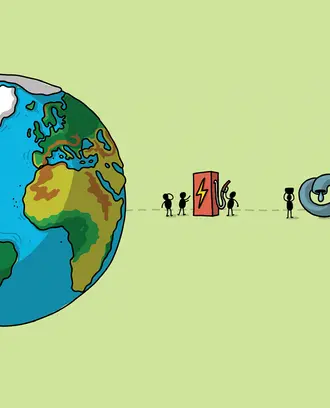Credit: Miha Creative / Shutterstock
“Think globally, act locally” has long been a mantra of grassroots environmentalists. Now, experts confronting the climate crisis are adding “scale thoughtfully” to that list.
This year’s MIT Sustainability Summit celebrated the power of grassroots solutions, examined environmental justice, and detailed ways local visions can align with global efforts. MIT senior lecturer in sustainabilitymoderated a panel of climate activists from the worlds of fashion, nature conservancy, and impact investing.
Here are their ideas for scaling grassroots social innovations for global good:
Align your business mission with a socially relevant ‘North Star’… and hire the right people to nudge it along.
One example: Pharmaceutical company Boehringer Ingelheim, which wanted to evolve its mission from a more narrow focus on pharmaceuticals to improving health for everyone, particularly those in marginalized communities.
In 2011, the company partnered with Ashoka, which identifies and supports a global network of “social entrepreneurs” — individuals with innovative solutions to pressing social, cultural, and environmental challenges.
Some 64% of millennials won’t take a job if it doesn’t have a strong corporate social responsibility policy.
To reinforce its mission of “health for everyone” within its organization, Boehringer worked with Ashoka to embed the concept of “change-making” into its professional development, said Gretchen Zucker, who leads strategy and strategic partnerships at Ashoka.
Ashoka also offers an executive-in-residence program.
“We help broker joint-venture partnerships with some of our social entrepreneurs that are providing last-mile health or other forms of health impact,” Zucker said. “This has led to dozens of new business lines created by those executives who were in residence with some of our social entrepreneurs. Today, 6,000 employees at Boehringer Ingelheim are involved in these change-making initiatives.”
One example is Boehringer’s funding of the Access Afya program, which delivers health care in Kenya by providing apps to measure blood pressure, pop-up clinics, and financial aid for patients.
Such social entrepreneurship doesn’t just improve outcomes for marginalized communities, it makes good internal business sense: The Cone Communications Millennial Employee Study found that 64% of millennials won’t take a job if it doesn’t have a strong corporate social responsibility policy, and 83% would be more loyal to a company that helps them contribute to social and environmental issues.
Make social change appealing
It’s important to translate complex situations and issues for public consumption. Messaging matters, said Céline Semaan, co-founder and CEO of fashion sustainability incubator Slow Factory.
“Policy change needs the support of the public. And how do we get the support of the public? It’s not just through doom and gloom, and everything’s going to collapse,” she said. “It’s not just policy and a very austere group of people who are meeting [to change] laws and whatnot. It is about opening the doors to creatives, to artists, to designers, to anybody — thinking creatively as a community and … lowering the barrier to entry.”
Slow Factory offers a free series of intersectional classes on topics such as colonialism, the ethics of space exploration, and racism in fashion supply chains. It also hosts open design challenges focusing on upcycling. The organization is currently building a brick-and-mortar space in Brooklyn for classrooms, a theater and community space, and a lab-grown plant-based leather production facility.
Slow down to go fast
All of the panelists emphasized thoughtful investing, apprenticeships, and “patient capital” — that is, funders giving social innovations the time and financial opportunities to grow and succeed without demanding results too quickly.
“Social entrepreneurs should be given the same latitude, the same support, the same success expectation rate as Silicon Valley, or all these other venture capital-funded businesses,” said Ngozi Okaro, executive director of fashion business incubator and training institute Custom Collaborative.
“Whatever you’re good at, you can change the world. You just need the opportunity,” said Dune Lankard, president and founder of Native Conservancy, which is focused on protecting Indigenous, endangered Alaskan habitats. “Organizations that fund people like us really need to trust our process, our local knowledge, and the speed at which things move.”
Native Conservancy offers a program to empower and equip young Indigenous people with the resources and training to start their own kelp farms, thereby creating economic opportunities while also supporting the health of the ocean and connecting the youths to a traditional food source.
“We're going to scale up by scaling down. We’re going to work with these villages in communities to help give them the tools, so they can change the relationship with their food source, and take care of their communities in this time of hardship, and be able to feed themselves,” Lankard said.
And this is an ongoing, not an overnight, process. MIT Sloan’s Jay pointed out that, in the rush for change, organizations could set themselves up for failure by moving too quickly.
Related Articles
“We could say we want to do energy efficiency retrofits of every building in Massachusetts in two years, but the reality is that the construction workforce to do that isn’t there,” he said. “The companies that have tried to move too fast have actually overshot and collapsed.”
Prioritize empathy
Zucker urges everyone in an organization, not just senior leadership, to think like a change-maker — that is, someone who believes every decision has the capacity for global implications. This requires emotional intelligence, which can be taught.
“The first and most important ingredient of being a change-maker is empathy. It’s really hard to approach a problem, devise a solution, and create positive change for the good of all unless you have empathy skills,” she said, meaning the capacity to find common ground and lead by example.
Democratize higher education
Underpinning each of these efforts is the need for a workforce of sustainability-minded entrepreneurs who shouldn’t have to compromise ideals for salary and tuition, Zucker said.
How do we get more socially minded young people into the pipeline? Top universities, MIT among them, should be more affordable to attract a broader swath of change-making talent, said Zucker, who earned an MBA from MIT Sloan in 1999.
Increasing enrollment and decreasing tuition could help.
“If we had 10 times the number of MIT students or a tenth of the cost of an MIT education, then think of how many more change-makers would be apprenticing,” she said. “The more change-makers there are, the more likely solutions will outrun problems.”
Read next: MIT clean tech companies to watch



